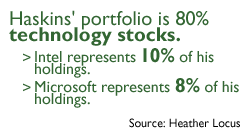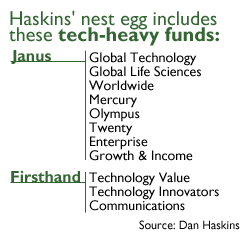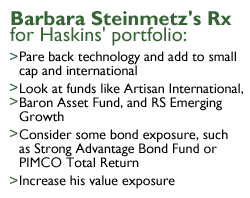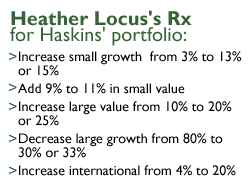NEW YORK (CNNfn) - Dan Haskins, a 47-year-old veterinarian from Washington state, admits he felt a little queasy when the Nasdaq plunged this spring and his long-term portfolio lost $120,000.
But Haskins hasn't lost faith in technology, and he's betting that stocks like Intel and Microsoft will help him reach his retirement goal of having $1 million saved by the time he stops working in nine years.
"When I saw my stocks fall it made my stomach turn," Haskins said. "But technology has been my focus ... I believe that is the future growth area and therefore holds the most potential."
Many financial advisers say that asset allocation, or how you divide your dollars between stocks, bonds and other investments, is one of the most important factors to reach your goals.
 Portfolio Rx is a new CNNfn.com feature that looks at issues like diversification, asset allocation and rebalancing. In each article, we will review a person's long-term investing portfolio and ask financial experts to give their advice. If you want help with your nest egg, see below for more information. Portfolio Rx is a new CNNfn.com feature that looks at issues like diversification, asset allocation and rebalancing. In each article, we will review a person's long-term investing portfolio and ask financial experts to give their advice. If you want help with your nest egg, see below for more information.
By diversifying your investments, you'll protect your portfolio from volatility, because when one part of the market is in a correction, another part will do well.
Some asset allocation plans are as complicated and detailed as a calculus equation. But generally, the categories include large-, mid- and small-cap stocks on the growth and value sides; international investments; bonds and cash.
 How you allocate your dollars depends on factors such as your age, risk tolerance, long-term investing goals, and income level. The younger you are, the more risk you can afford to take. As you get closer to retirement, you'll want to shift some of your money into more conservative investments so you won't risk losing your principal. How you allocate your dollars depends on factors such as your age, risk tolerance, long-term investing goals, and income level. The younger you are, the more risk you can afford to take. As you get closer to retirement, you'll want to shift some of your money into more conservative investments so you won't risk losing your principal.
Financial pros also advise people to "rebalance" or check their portfolio periodically to make sure they're still diversified. For example, since growth stocks have performed so well in recent years, your portfolio may be underweighted in value holdings.
"In a perfect world, we'd like to be able to pick which asset class is going to do well, but no one knows when it's going to cycle," said Heather Locus, a certified financial planner with Balasa & Hoffman in Schaumburg, Ill.
Haskins: A careful saver
Haskins and his wife of 27 years, Linda, live in a small town about 50 miles north of Seattle on the coast. He and five partners own Northwest Veterinary Clinic, a bustling veterinary hospital that is opening a third branch. He treats dairy cows, horses, goats and sheep.
Two of the couple's four children are grown, and the other two are teen-aged boys. Linda Haskins is a baker in the local school district.
Haskins earns $100,400 a year in salary and other income, while his wife earns $17,000. The family home, on 10 acres of land, is valued around $480,000. They have $19,000 in checking and money market accounts, part of which they want to use for a trip to Europe next year.
 Their only debt is an $85,000 mortgage on the property at 7.5 percent interest, and a $44,000 second mortgage at 8 percent. Haskins took out the second mortgage to build a barn and wood shop where he plans to spend his time tinkering when he retires. Their only debt is an $85,000 mortgage on the property at 7.5 percent interest, and a $44,000 second mortgage at 8 percent. Haskins took out the second mortgage to build a barn and wood shop where he plans to spend his time tinkering when he retires.
Haskins said he started investing about 15 years ago with zero-coupon bonds for his kids. Over the years, he started learning about the market as he decided on investments for his SARSEP-IRA, Roth IRAs for him and his wife, and investing accounts that included college savings funds. (A SARSEP-IRA, or Salary Reduction SEP-IRA, is a type of IRA plan for small businesses that was available for new accounts until 1997.)
The SARSEP-IRA has about $375,000, while the two Roth IRAs have about $8,000 each. They also have about $75,000 in taxable investment accounts.
Travel and time in the woodshop
He plans to sell his stake in the business when he retires and get a monthly payment of roughly $3,000. He hopes that income, plus the sale of some of his investments, will be enough to support them until he starts collecting Social Security at 62. If not, he figures he can dip into his SARSEP-IRA.
When the couple retires, they'd like to keep the home and five acres of the land and spend about $10,000 a year traveling in the United States and overseas. He estimates he'll need $70,000 to $75,000 a year in income.
"Otherwise our plans are simple - continue fixing up the place and enjoying the grandkids," Haskins said. "The wood shop will be a busy place, I hope."
He's used online financial calculators to find out if he is on track to meet his goals, using an annual rate of return of 12 percent.
 "There was no specific asset allocation done," Haskins said. "I never sat down and said I'm going to have this much in stocks, this much in bonds, and this much in international." "There was no specific asset allocation done," Haskins said. "I never sat down and said I'm going to have this much in stocks, this much in bonds, and this much in international."
Still, Haskins thinks he has the right allocation for someone of his age and risk tolerance.
"I think I should have more money in the financial services sector," Haskins said. "But I'm not willing to sell my tech stocks to move in that direction. If I had new money to invest, I'd put it there (in financial stocks) ... technology has been the focus. I still think it's the right weighting."
As far as value stocks go, he said he was dissatisfied with a small-cap value fund he owned in his kids' college fund. It performed so poorly that he got soured on the category.
"It just stunk for a year," Haskins said of the value fund.
What the experts say
Barbara Steinmetz, a certified financial planner from Burlingame, Calif., praised Haskins for his commitment to saving. At the same time, she said his portfolio is extremely aggressive and tech-heavy.
"There's nothing wrong with anything he's picked," Steinmetz said. "I'm just concerned about his lack of diversification. Technology has been wonderful in the past two years. But he's sitting out there on a limb if we have an extended downturn."
 While Haskins knows he's got a lot of exposure in Microsoft - representing about 8 percent of his holdings, he has an even larger weighting in Intel of about 10 percent, Steinmetz said. While Haskins knows he's got a lot of exposure in Microsoft - representing about 8 percent of his holdings, he has an even larger weighting in Intel of about 10 percent, Steinmetz said.
"The reason he's done so well is large caps have been the place to be," Steinmetz said. "But that's not the way it's always going to be."
Steinmetz and Locus also pointed out that the Janus funds have many overlapping stocks.
"He's not diversifying at all with his Janus holdings," Locus said. For example, the funds own Lucent, Microsoft, EMC, Cisco, Sun Microsystems, Texas Instruments, Amazon.com, I2 Technology, and Sprint.
Locus said she has the same discussion about diversifying with her clients. She tries to tell them that even though technology is an important part of the future, it might not always translate into stellar returns. Part of that future potential is already priced into the stock, she said.
Steinmetz would cut Haskins' technology exposure and add more small caps and international holdings. She'd also recommend some bond exposure. She'd make the changes in his tax-deferred accounts to avoid triggering any capital gains.
Instead of reinvesting dividends into the same stocks, Steinmetz thinks Haskins could put that money to work in new holdings. Or, he could use a strategy called dollar-cost averaging, where you take a little money at a time and invest it.
Check your mutual funds on CNNfn.com.
Another factor for Haskins to keep in mind is that he hasn't apparently accounted for inflation in his calculations, Steinmetz said. He may think he needs $75,000 a year in today's dollars, but at a 3.5 percent rate of inflation, he'll need $102,217 to pay for the same things in nine years.
Locus would lower Haskins' large growth stock exposure from 80 percent to 33 percent. She would increase the following sectors: Small growth, 13 percent to 15 percent; small value, 9 percent to 11 percent; large value, 20 percent to 25 percent; and international stocks, to 20 percent.
"It's interesting that he's been very good managing his debt," Locus said. "His lifestyle in general is of a very conservative person. But his portfolio is extremely aggressive."
Locus did a retirement projection for Haskins and found that he's on target to retire in nine years if he averages a rate of return of at least 9 percent. But, if he gets an average return of 8 percent he'll have to work 11-1/2 years.
"He's done a good job of saving and keeping debt low," Locus said. "He needs to keep up with his projections to make sure he stays on track. If the market is not good for the next nine years, he's going to have to work harder."
* Disclaimer
If you want to be considered for our Portfolio Rx feature, send us an e-mail at retirement@cnnfn.com. Please include your age, occupation, income, assets, debt and expenses. In addition, please tell us about your retirement goals, such as when you wish to retire and what type of lifestyle you envision. Also include specifics about your long-term savings portfolio: your 401(k) and IRA accounts; which mutual funds, stocks and other securities you own; and information about any other source of retirement income you expect, such as a pension. 
|

